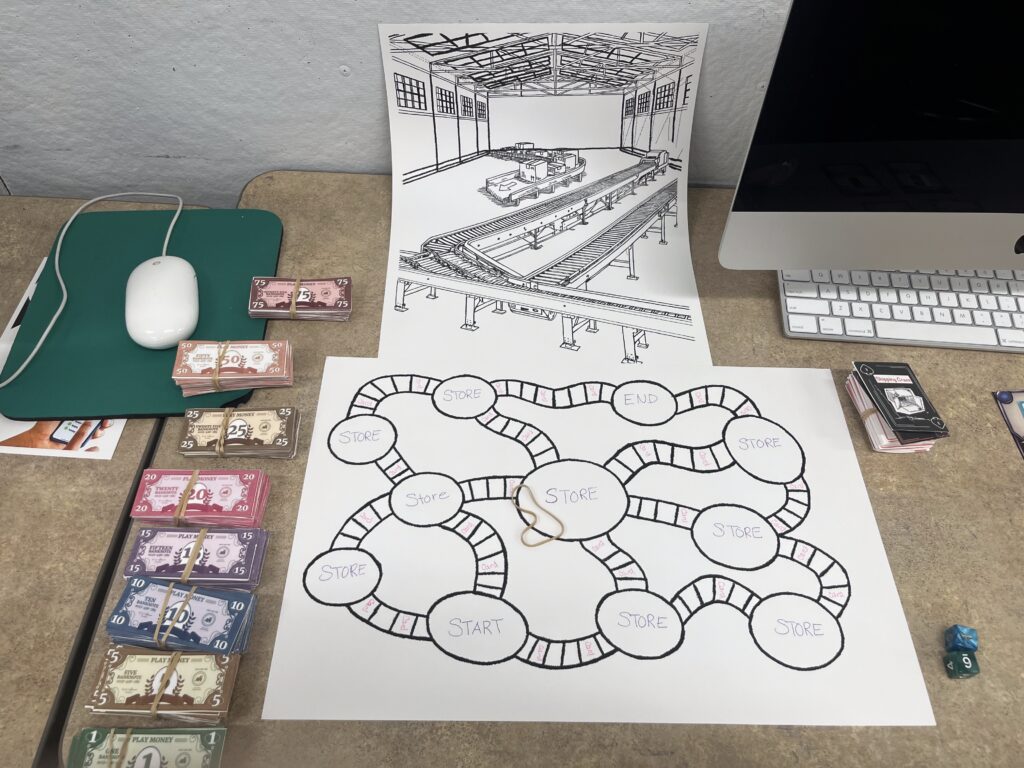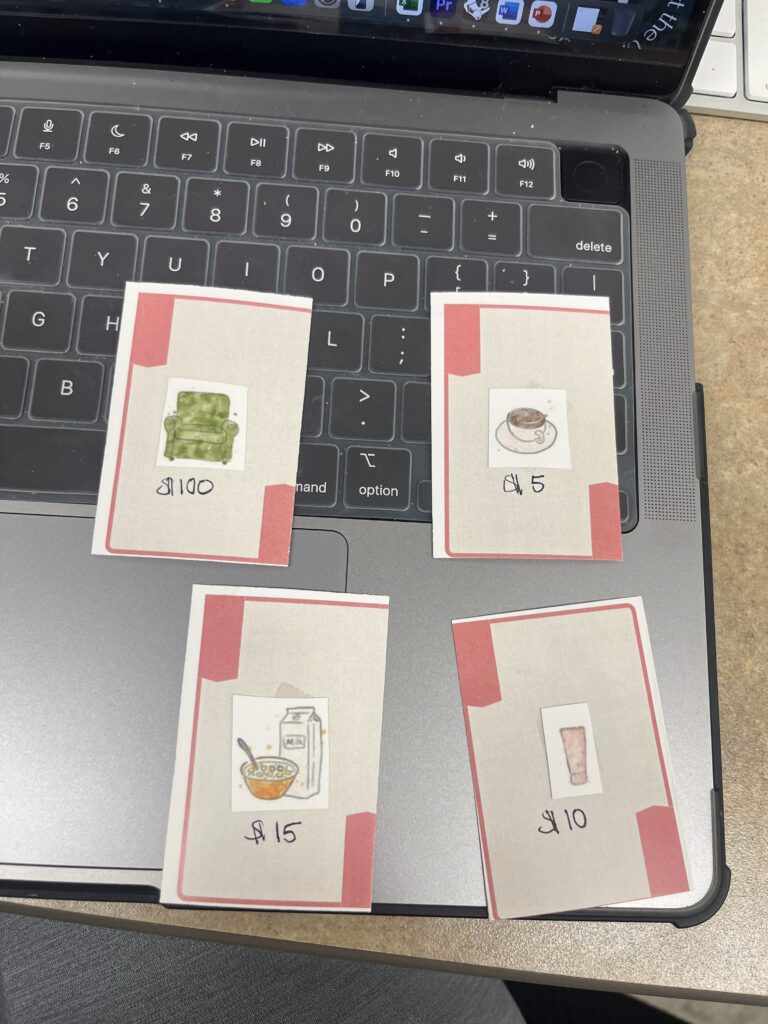Short Summary
Shipping Craze is a fast-paced tabletop game where 4-6 players take on the roles of savvy merchants, racing to gather products, manage funds, and build the highest-value “house” by purchasing items from a shared store. Players roll dice, land on spaces to collect money, and make strategic purchases to build their collections. The goal is to be the merchant with the most valuable house when all store items are sold or no one can afford more products.
This game is perfect for players aged 12 and up who enjoy strategy, competition, and a bit of luck.
Design Process & Thought Process:
- Game Design Document (GDD):
Game Design Document
Core Concept: The game is centered around the theme of product collection and strategic purchases. Players must manage their money effectively and plan their acquisitions carefully to maximize the value of their personal "house" before time runs out or the store empties.
Message/Purpose: The purpose of Shipping Craze is to engage players in a competitive environment where they must balance risk and reward, manage resources (money), and make strategic decisions. The game challenges players to think ahead and outsmart their opponents to accumulate the most valuable set of products.
Rules and Mechanics:
Dice Rolling: Determines movement on the board, creating an element of luck.
Product Cards: Represent money earned, creating a balance between luck (drawing cards) and strategy (spending money wisely).
Store Items: A shared resource that players can purchase from, encouraging competitive decision-making.
Bankruptcy: Forces players to rethink their strategies when they run out of money.
Double Rolls: Adds a layer of excitement and risk, providing an extra turn for lucky players but also the risk of losing a turn after three consecutive doubles.
- Iterative Design: Showcase how you iterated on the game design, highlighting the challenges you faced and the decisions you made.
The design process of Shipping Craze began with the core mechanic of collecting products to build a valuable house. The initial iteration was quite simple, with players moving around the board and collecting items, but it lacked strategic depth. Early testing revealed that players often rushed to buy whatever they could, resulting in an unsatisfying game that didn’t reward long-term planning.
Key Decisions Made:
I introduced the concept of a "house" where players store purchased products to help them track their progress and give them a visual goal to work toward.
A store with limited products was added to introduce competition and prevent players from hoarding resources without challenge.
I added the rule for bankruptcy to add tension and prevent players from simply buying low-value items repeatedly.
The Double Roll rule was implemented to keep the game dynamic and prevent players from becoming complacent.
- Game Mechanics: Explain the key game mechanics in detail, using diagrams or screenshots, or photos to illustrate them.
Game Mechanics
The game is centered around three key mechanics:
Dice Rolling: Players roll two dice on each turn to determine how far they move on the board. Rolling doubles gives players an extra turn, but rolling three doubles in a row results in forfeiting a turn.
Collecting Products: Players land on spaces to draw Product Cards, which provide them with money tokens. The money earned helps players purchase store products.
Purchasing Products: The products in the store are limited, and players must carefully choose which items to buy with their accumulated money. Items vary in price and value, requiring players to think strategically about when and what to purchase.
- Player Goals: Clearly define the players’ objectives and how they achieve victory.
Players aim to build the highest-value house by purchasing items from the store. The value of each product is represented by the money it earns when collected. At the end of the game (when the store is out of products or players can no longer afford to buy), the player with the most valuable house wins. To achieve this, players must:
Collect money by drawing product cards.
Strategically purchase valuable items from the store.
Monitor the other players’ progress to prevent them from getting ahead.
- Gameplay Sequence: Include images or videos demonstrating different stages of gameplay, highlighting key moments and player interactions.
Gameplay Sequence
The game unfolds in a series of turns:
Roll the Dice: The player rolls two dice to determine movement.
Land on a Space: The player lands on a space that might allow them to collect a product card or purchase from the store.
Product Collection: If a player lands on a "Pick up a Product" space, they draw a Product Card and receive money based on the card’s value.
Purchasing: Players may then spend their collected money to buy products from the store.
End Turn: Once purchases are made, or the player opts not to buy anything, their turn ends, and the next player takes their turn.
- Game Board & Components: Show good pictures of the game board and components, explaining how they guide or influence player actions.
The Shipping Craze board includes spaces for dice rolling, product collection, and the store where players can buy items. The board is divided into different segments, such as "Start" and "Product Spaces," where players can land to collect products.
Components:
Dice (2): To determine movement.
Product Cards (200): Cards representing products and the money earned when collected.
Store Items (150): Physical items for sale in the store, each with a price tag.
Money: Represent the cash players use to make purchases.
Player Markers: Used to track the player's position on the board.
Product Boxes (3): Store items are kept here for players to purchase.
The store is the focal point of the game’s strategy, influencing player decisions as they navigate the board and plan purchases.

Board/Set up

Store Items



Rulebook & Playtesting:
- Rulebook Sample: Include a sample of your rulebook, demonstrating your writing and communication skills.
- Playtesting Notes: Share any notes or feedback from playtesting sessions, showcasing your ability to identify and address issues.
Playtesting Notes
Player Questions:
Players were curious about potential player-to-player interactions, such as trading or sabotaging, which aren't currently part of the game. Others asked what happens when the Product Deck or store items run out, leading to minor confusion about the late-game flow.
Learning Curve:
Most players learned the game very quickly—within about 5 minutes of explanation. While the core mechanics (rolling, collecting, buying) were easily grasped, the strategic timing of purchases and resource management took a bit longer to click.
Player Interactions:
Interaction between players was mostly indirect—centered on competition for store items and comparing purchases. Some players added fun by joking about each other's earnings and choices. However, deeper interactions like blocking, stealing, or trading were missing, which some found limiting.
Confusion Points:
Players were unclear on when they could access the store. Some believed they could buy items as soon as they had the funds, not realizing they needed to land on a store space. Others weren’t sure what to do when they had no money or if the store was out of items.
Player Enjoyment:
Players really enjoyed collecting products, building their “house,” and anticipating dice rolls. Big moments—like pulling a high-value card or rolling doubles—sparked a lot of excitement.
Frustrations:
Players felt frustrated when stuck with low-value items or when they couldn’t make purchases due to lack of money. The bankruptcy rule, while useful in adding tension, could feel punishing and left some players with little to do. Some also struggled when the store ran out of products.
Takeaways:
Although the game wasn’t designed to teach lessons explicitly, players came to understand that hoarding money for expensive items isn’t always the best strategy. Many realized that buying multiple smaller items could be just as effective, aligning with the game’s intended message about balancing price and value.
- Game Reflections: Discuss what you learned from the development process and what you would do differently next time.
What I Learned
The biggest takeaway from developing Shipping Craze is the importance of balancing strategy and player interaction. While players enjoyed collecting and competing for resources, they wanted more ways to interact beyond just racing for items. The excitement of dice rolls and product draws was strong, but the independent nature of play could sometimes make it feel solitary.
Addressing Feedback
To address confusion and enhance interaction:
I plan to redesign the store layout to make it more visible and accessible for all players.
I'll add a new "Chance Card" mechanic to bring more dynamic events into play. These cards could let players:
Steal items from other players
Take free products from the store
Freeze an opponent’s turn
Earn surprise bonuses
This addition will introduce risk-reward dynamics and promote more player engagement.
What I will Do Differently
In the next iteration, I will:
Refine rules around store access to make them clearer.
Introduce more layered strategy, like card combos or item synergies.
Possibly explore team modes or multiplayer challenges to enhance social gameplay.
While the game was successful in encouraging smart spending and value assessment, I want future versions to offer deeper player interaction and less downtime, especially when players fall behind.
